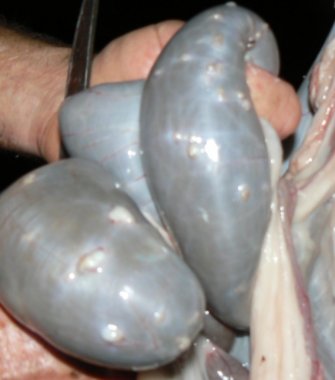Two species of Oesophagostomum occur in Australia, Oesophagostomum columbianum (nodule worm) in the summer rainfall areas and Oesophagostomum venulosum (large bowel worm) in winter rainfall areas. Oes. columbianum is much more pathogenic than Oes. venulosum and causes 'nodules' in the large intestine and colon of the sheep and goats. Oes. venulosum is rarely pathogenic and does not produce nodules.
Modern broad-spectrum drenches tend to keep these worms at low levels; even so, these can cause economic loss through damage to the intestinal wall, making the intestines useless for sausage casings.
Nodule worm is a large (20 mm) white stout worm with the adult female laying 5,000–12,000 eggs per day. The L3 (third-stage larvae) of Oes. columbianum are susceptible to cold and dry conditions and die in frosty sub-zero temperatures, whereas infective larvae of Oes. venulosum are more cold-tolerant. Development of ingested L3 to egg laying adult takes about 5 weeks.
Adult nodule worms live in the large intestine of the sheep and goats, and cause damage to the lining of the gut. This damage occurs when larvae migrating through the wall become trapped and calcified or caseous (specifically Oes. columbianum) producing the condition called 'knotty gut' or ‘pimply gut’.
Further ecological information on worms and their control:

Nodule worm and large bowel worm are found in the large intestine of the sheep and goats.
Nodule worm (Oesphagostomum columbianum), if present in numbers, causes severe disease: lethargy, weight loss, damage and inflammation of the gut resulting in marked and persistent green mucoid diarrhoea (scouring), nodular lesions in large and sometimes the small intestine, and humped back from abdominal pain.
Typically, weaners show ill-thrift, often standing with a characteristic humped back, they lose condition, become weak and scour intermittently. Nodules form around the developing larvae in the intestinal wall and are clearly visible to the naked eye. Nodules in the small intestine are small and gritty, and those in the colon larger with soft centres. The colon is reddened, thickened and oedematous and adult worms are clearly visible on post-mortem.
Large bowel worm (Oesophagostomum venulosum) may cause production losses in young sheep or goats if present in large numbers, but rarely disease. Some experimental infections have resulted in scours and ill-thrift. Large bowel worm does not form nodules or any specific lesions in the intestines, but worms are clearly visible in the blind gut (caecum) of infected animals. It generally does not cause a problem for adult sheep or goats.
The only accurate way to diagnose worm infections before productivity losses have occurred is to conduct a WormTest (worm egg count). The results allow you to make the best choice of drench for the situation. For stock in hot summer rainfall regions a larval culture is important to identify if Oes. columbianum is also present in the worm population along with barber’s pole.
Visual signs only occur after significant production loss has already occurred. Also, these signs can occur with other parasites and diseases.
Nodule worm can be diagnosed during a post mortem, when nodules and the worms are seen.
The nodules on the wall of the rectum can be detected and palpated during collection of faecal samples.
There are many options to treat for this worm and your choice will depend on:
Your decision can be assisted by using the Drench Decision Guide, a simple tool that considers some of the points above.
You can also review the Drench pages on this site to find out specific information about drenches, including their drench active, drench group, length of protection, which worms they treat, dose rate, withholding period, export slaughter interval and manufacturer.
Note: only a few drench types are registered for use in goats.
The negative impact of this worm can also be reduced through browsing and grazing management strategies and by using one of the integrated worm control programs that have been developed for different regions across Australia.